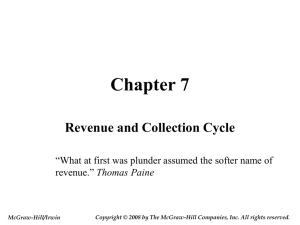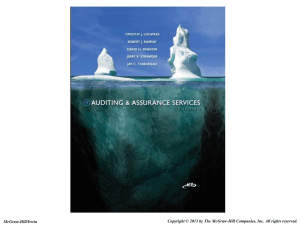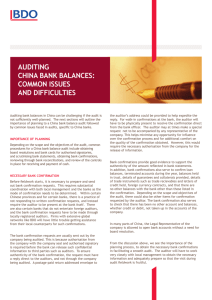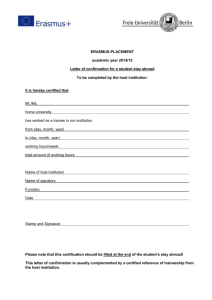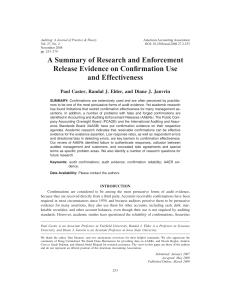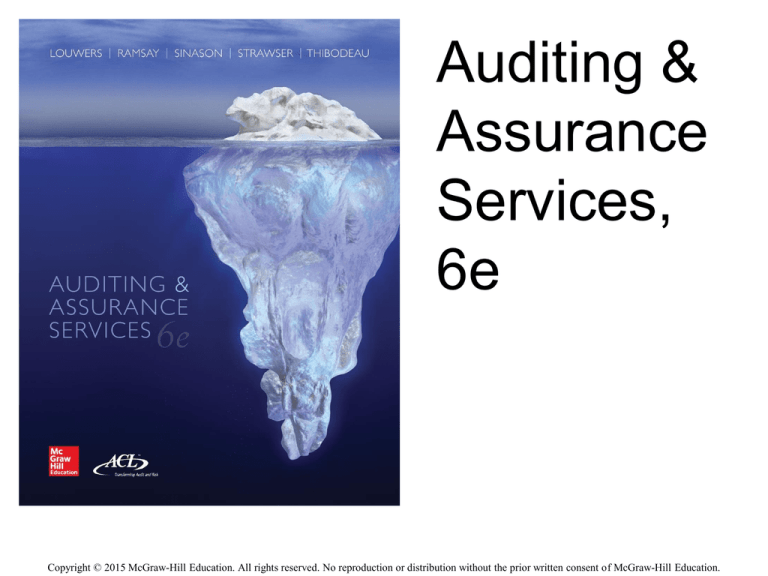
Auditing &
Assurance
Services,
6e
Copyright © 2015 McGraw-Hill Education. All rights reserved. No reproduction or distribution without the prior written consent of McGraw-Hill Education.
Chapter 07
Revenue and Collection Cycle
“What at first was plunder assumed the softer name of
revenue.” Thomas Paine
7-2
Learning Objectives
1. Discuss inherent risks related to the revenue and
collection cycle with a focus on improper
revenue recognition
2. Describe the revenue and collection cycle,
including typical source documents and control
procedures.
3. Give examples of tests of controls over customer
credit approval, delivery, and accounts
receivable accounting
7-3
Learning Objectives (continued)
4. Give examples of substantive procedures
in the revenue and collection cycle and
relate them to assertions about account
balances at the end of the period.
5. Describe some common errors and frauds
in the revenue and collection cycle, and
design some audit and investigation
procedures for detecting them.
7-4
Overall Audit Approach
7-5
Inherent Risks
• Improper Revenue Recognition
– Cut-off
– Bill and Hold
– Channel Stuffing
• Returns and Allowances
• Collectibility of Receivables
7-6
Revenue Recognition
• Must be (1) realized or realizable and (2) earned
• SEC guidance (SAB 104)
– Persuasive evidence of an arrangement exists,
– Delivery has occurred or services have been rendered,
– The seller's price to the buyer is fixed or determinable,
and
– Collectibility is reasonably assured
7-7
7-8
Exhibit 7.2
Revenue
Recognition
Rogues
7-8
Exhibit 7.3
Revenue
and
Collection
Cycle
7-9
REVENUE AND COLLECTION CYCLE:
Key Control Procedures
•
SEPARATION OF DUTIES
– Separate functions for recording, authorization, custody
•
AUTHORIZATION OF TRANSACTIONS
–
–
–
–
Write-offs
EDI transactions
Credit checks prior to approval of sale
Pricing
•
ACCESS TO ASSETS
•
– Shipping department
– Lock box account
ADEQUATE DOCUMENTS AND RECORDS
–
–
•
Pre-numbered sales orders, shipping documents (bills of lading), sales invoices
Remittance advice
INDEPENDENT CHECKS ON PERFORMANCE
–
–
A/R subsidiary ledger to general ledger
Monthly statement to customer
7-10
Audit Evidence in Management
Reports and Data Files
•
•
•
•
•
•
•
•
Pending order master file
Credit check/approval files
Price list master file
Sales detail file (sales journal)
Sales analysis report
Accounts receivable aged trial balance
Cash receipts listing
Customer Statements
7-11
Other Controls
•
•
•
•
•
•
•
•
No sales order without customer order.
Credit approval.
Restricted access to inventory.
Restricted access to terminals and invoices.
All documentation in order to record sales.
Proper dating.
Invoices compared to BOLs and orders.
Pending order files reviewed.
7-12
Exhibit 7.5 Assertions about Classes of
Transactions and Events for the Period
7-13
Exhibit 7.6
Dual Direction of Test Audit Sample
7-14
Exhibit 7.7
Assertions and Substantive Procedures in
the Revenue and Collection Cycle
7-15
AUDITING ACCOUNTS RECEIVABLE
• Test Accounts Receivable Aged Trial Balance
(Exhibit 7.8)
• Confirm balances.
• Perform analytical procedures
• Test sales cut-off
7-16
Exhibit 7.8
Accounts Receivable Aged Trial Balance
7-17
USING CONFIRMATIONS
• Primarily for verifying EXISTENCE.
• Factors likely to affect the reliability of
confirmations
– Previous audit experience
– Intended recipient of the confirmation
– Type of information being confirmed
• The auditor may confirm entire BALANCES
or individual TRANSACTIONS.
– Type of confirmation being sent
7-18
TYPES OF CONFIRMATIONS
• Positive Confirmations
– small number of accounts are involved
– large number of errors are anticipated
• Negative Confirmations
– the combined assessed level of inherent and control risk is low
– a large number of small balances is involved
– the auditor has no reason to believe that the recipients of the
requests are unlikely to give them consideration.
• Blank Confirmations should be used if the recipient is
likely to return a positive confirmation without verifying
the accuracy of the information.
7-19
Exhibit 7.9
Positive
Confirmation
Letter
7-20
Exhibit 7.10
Negative
Confirmation
Letter
7-21
CONFIRMATION CONSIDERATIONS
• All confirmations returned by the post office as
non-deliverable must be investigated
• Responses to positive and blank confirmations
provide more reliable evidence than negative nonresponses.
• Recipients of accounts receivable confirmations
might not report understatements.
• Auditors must have heightened professional
skepticism for electronic responses (fax or e-mail).
– Verify that the response came from an appropriate
person at the employer
7-22
CONFIRMATION CONSIDERATIONS
(Continued)
• Non-response to Positive/blank confirmation
requests
– Follow up with second and sometimes third requests.
– A lower than expected response rate could be indicative
of fictitious customer accounts.
– Alternative procedures.
• Non-response to negative confirmation requests
– Only limited evidence concerning financial statement
assertions.
– Alternative procedures are not necessary for unreturned
negative confirmation requests.
• Follow-up on all exceptions
7-23
Exhibit 7.11
Responses to Positive Confirmations
7-24
ALTERNATIVE PROCEDURES
• Vouch subsequent cash collections
– usually sufficient evidence of existence,
valuation.
• Examine shipping documents
– Especially BOL (third-party evidence)
• Examine client-generated supporting
documentation, such as invoices.
– Depends on internal controls
• Inspect correspondence files
7-25
Other Matters Related to
Confirmation
• There are three sets of circumstances that could justify the
omission of the confirmation of a client's accounts
receivable.
– Not material to the financial statements.
– If the RISK OF MATERIAL MISSTATEMENT is low
• the assessed level of evidence from analytical procedures and other
tests of details is sufficient to reduce audit risk to an acceptably low
level
• confirmation of accounts receivable may be inefficient.
– Confirmation of accounts receivable is expected to be ineffective
(based on previous years' audit experience).
7-26
UNCOLLECTIBLE
ACCOUNTS
• Inspect customer files for collectibility
• Recalculate ALLOWANCE and BAD DEBT
EXPENSE
• Verify reasonableness of ALLOWANCE and BAD
DEBT EXPENSE
• Inspect documentation for appropriateness of
accounts written off
– Inspect documentation for additional collection procedures
– Inspect documentation for appropriate authorization.
7-27
ANALYTICAL PROCEDURES
• Sales Revenue
– Comparisons with previous periods
– Comparisons with industry
• Allowance for Doubtful Accts, Bad Debt Expense
– Bad Debt Expense as a percentage of Sales
– Allowance for Doubtful Accounts as a percentage of
Gross Receivables
• Accounts Receivable
– Days Sales in Accounts Receivable
– Accounts Receivable Turnover
7-28
SALES CUTOFF PROCEDURES
• Used to verify whether Sales/Revenues
recorded in the CORRECT ACCOUNTING
PERIOD.
– Holding the books open
• Examine SALES INVOICES and SHIPPING
DOCUMENTS shortly prior to and after yearend.
• Examine returns after year-end.
7-29

